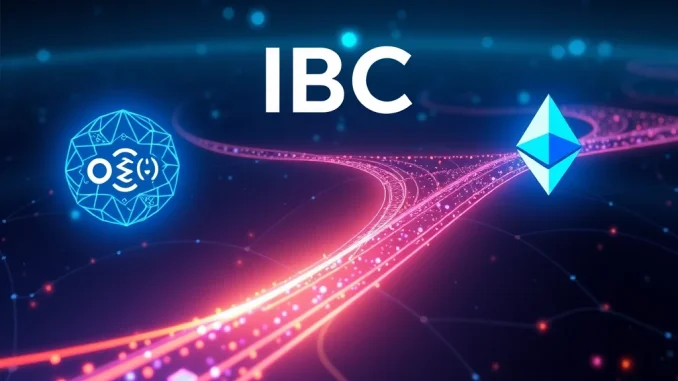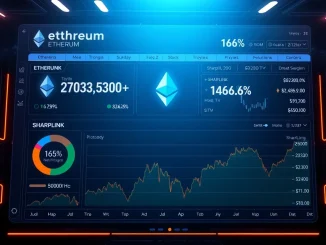
Exciting news for crypto enthusiasts! Imagine a world where blockchains communicate effortlessly, exchanging value and data without friction. That future is rapidly approaching, and the latest development from the Cosmos ecosystem is a giant leap in that direction. Cosmos, known for its vision of an ‘Internet of Blockchains,’ just achieved a significant milestone: a successful test transaction leveraging the Inter-Blockchain Communication (IBC) protocol to connect with Ethereum. Let’s delve into what this groundbreaking achievement means for the crypto space and why it’s a game-changer for cross-chain interoperability.
Unveiling the Power of Cross-Chain Interoperability
In the often siloed world of blockchain, the dream of seamless communication between different networks has been a long-sought-after goal. Cross-chain interoperability is the ability for different blockchains to interact, share data, and transfer assets with each other. Think of it as building bridges between isolated islands, creating a connected continent. Why is this so crucial?
- Breaks Down Silos: Currently, many blockchains operate independently. Interoperability breaks down these walls, allowing for a more fluid and interconnected ecosystem.
- Enhances Liquidity: Assets can move freely between chains, increasing liquidity and efficiency across the entire crypto market.
- Expands Use Cases: Developers can build applications that leverage the strengths of multiple blockchains, unlocking new and innovative possibilities.
- User Empowerment: Users gain more flexibility and control over their assets, choosing the best blockchain for their specific needs.
The lack of interoperability has been a major hurdle in the blockchain space, hindering mass adoption and limiting the potential of decentralized technologies. Cosmos is tackling this head-on with its IBC protocol, and the recent test with Ethereum marks a pivotal moment in this journey.
Cosmos and the IBC Protocol: A Deep Dive
Cosmos (ATOM) is not just another blockchain; it’s an ecosystem designed to connect blockchains. Its core mission is to create an ‘Internet of Blockchains,’ a network of interconnected, independent blockchains capable of communicating with each other. The IBC protocol is the engine that drives this vision. Let’s break down what makes Cosmos and IBC so unique:
What is Cosmos?
Cosmos is a decentralized network of independent, scalable, and interoperable blockchains. It provides a framework and tools for developers to easily build their own blockchains, known as ‘zones,’ and connect them to the Cosmos Hub. Key features of Cosmos include:
- Tendermint BFT Consensus: A secure and high-performance consensus algorithm that powers the Cosmos Hub and many Cosmos zones.
- Cosmos SDK: A modular framework that simplifies blockchain development, allowing developers to build custom blockchains tailored to their specific needs.
- IBC Protocol: The Inter-Blockchain Communication protocol, the cornerstone of Cosmos’ interoperability vision.
Understanding the IBC Protocol
The IBC protocol is a standardized protocol that allows different blockchains to securely and reliably exchange data and assets. It’s like a universal translator for blockchains, enabling them to ‘speak’ the same language. Here’s how it works in simplified terms:
- Connection Handshake: Two blockchains establish a secure connection through a handshake process.
- Packet Relay: Data or assets are packaged into packets and relayed between the connected blockchains.
- Verification and Execution: Each blockchain verifies the packets and executes the corresponding actions, ensuring secure and trustworthy communication.
IBC is not just about simple token transfers; it’s designed to handle complex interactions between blockchains, opening up a world of possibilities for decentralized applications and services.
Ethereum and Cosmos: Bridging the Gap
Ethereum, the second-largest cryptocurrency by market capitalization, is a dominant force in the blockchain space, particularly for decentralized applications (dApps) and smart contracts. Connecting Cosmos to Ethereum is a monumental step towards realizing true blockchain interoperability. Why is this connection so significant?
- Vast Ethereum Ecosystem: Ethereum boasts a massive ecosystem of developers, users, and dApps. Bridging to Ethereum opens up Cosmos to this vast network.
- Smart Contract Power: Ethereum’s smart contract capabilities, combined with Cosmos’ interoperability, can lead to powerful cross-chain dApps.
- Increased Adoption: Making Cosmos assets and applications accessible to the Ethereum community can significantly boost adoption for both ecosystems.
The recent test transaction, as reported by The Block, involved successfully sending an IBC transaction from the Cosmos Hub to Ethereum. Maghnus Mareneck, co-CEO of Interchain Labs, highlighted the importance of this achievement in improving native interoperability between the two chains. This update is slated to be part of the upcoming IBC-go v10 “Eureka” upgrade, further solidifying Cosmos’ commitment to interoperability.
What Does the IBC-Ethereum Bridge Mean for the Future?
The successful test transaction between Cosmos and Ethereum using IBC is more than just a technical feat; it’s a glimpse into the future of a truly interconnected blockchain ecosystem. Let’s explore the potential implications:
Enhanced DeFi Opportunities
Decentralized Finance (DeFi) thrives on interoperability. A robust IBC bridge to Ethereum could unlock a wave of new DeFi opportunities, such as:
- Cross-chain Yield Farming: Users could seamlessly move assets between Cosmos and Ethereum DeFi platforms to optimize yield farming strategies.
- Interoperable Lending and Borrowing: Borrowing and lending protocols could operate across both chains, offering greater flexibility and capital efficiency.
- Cross-chain DEXs: Decentralized exchanges (DEXs) could facilitate trading between assets on Cosmos and Ethereum, enhancing liquidity and price discovery.
Innovation in NFTs and Gaming
Non-Fungible Tokens (NFTs) and blockchain gaming could also benefit immensely from Cosmos-Ethereum interoperability:
- Cross-chain NFT Marketplaces: NFT marketplaces could emerge that support NFTs from both Cosmos and Ethereum, expanding the reach and liquidity of NFT assets.
- Interoperable Gaming Assets: In-game assets could be transferred and utilized across games built on different blockchains, creating richer and more engaging gaming experiences.
Streamlined User Experience
For the average crypto user, interoperability translates to a simpler and more user-friendly experience. Imagine:
- One-Stop Wallets: Wallets that can manage assets across multiple blockchains seamlessly.
- Simplified Cross-chain Transfers: Transferring assets between different chains becomes as easy as sending a regular transaction.
- Unified dApp Access: Users can access dApps across different blockchains without the need for complex bridging procedures.
Challenges and the Road Ahead
While the Cosmos-Ethereum IBC bridge is a significant achievement, it’s important to acknowledge that challenges remain on the path to widespread cross-chain interoperability. These include:
- Security Considerations: Ensuring the security of cross-chain bridges is paramount. Robust security measures are crucial to prevent exploits and protect user funds.
- Scalability and Efficiency: As interoperability increases, ensuring scalability and efficiency of cross-chain transactions is vital to maintain a smooth user experience.
- Standardization and Adoption: Continued efforts are needed to standardize interoperability protocols and encourage wider adoption across the blockchain ecosystem.
Despite these challenges, the momentum behind cross-chain interoperability is undeniable. The Cosmos team, along with other projects in the space, is actively working to overcome these hurdles and build a truly interconnected blockchain future.
Conclusion: Embracing the Interconnected Future
The successful IBC test transaction from Cosmos to Ethereum is a landmark achievement in the quest for cross-chain interoperability. It signifies a major step towards realizing the vision of an ‘Internet of Blockchains,’ where different networks can communicate and collaborate seamlessly. As the IBC-go v10 “Eureka” upgrade approaches, the crypto world watches with anticipation, eager to witness the transformative potential of a more connected and collaborative blockchain ecosystem. The future of blockchain is not about isolated islands, but about bridges that connect them, and Cosmos is leading the charge in building those bridges, one groundbreaking transaction at a time.



